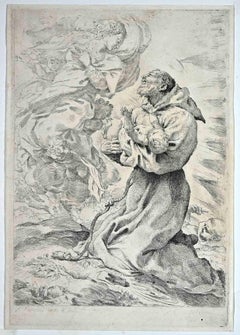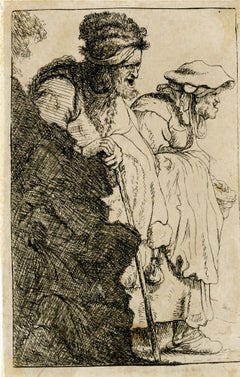Pietro Faccini Art
to
1
Overall Width
to
Overall Height
to
1
1
1
1
1
1
1
1
1
1
10,138
2,779
1,375
1,366
1
Artist: Pietro Faccini
Saint Francis with the Christ Child - Etching by Pietro Faccini - 17th Century
By Pietro Faccini
Located in Roma, IT
Saint Francis with the Christ Child is an etching print on paper realized by Pietro Faccini (1562-1602)
Beautiful proof.
Provenance: Collection G.S.S. Laub (Lugt 1221). Ref. Cat. P...
Category
17th Century Old Masters Pietro Faccini Art
Materials
Etching
Related Items
Beggar man and woman coming from behind a bank – after Rembrandt van Rijn
By Charles Amand Durand
Located in Middletown, NY
Etching on cream laid paper laid down to a wove paper support, 4 x 2 5/8 inches (101 x 67 mm) (sheet). In good condition with scattered light areas of discoloration. Printed early 19...
Category
17th Century Old Masters Pietro Faccini Art
Materials
Laid Paper, Etching
Self Portrait, Drawing at the Window
By Rembrandt van Rijn
Located in San Francisco, CA
Artist: Rembrandt Van Rijn (Dutch, 1606-1669)
Title: Self Portrait, Drawing at the Window
Year: 1648
Medium: Etching
Paper: Verge paper
Image (plate mark) size: 6.35 x 5.25 inch...
Category
Mid-17th Century Old Masters Pietro Faccini Art
Materials
Etching
Bust of a Man Wearing a High Cap, The Artist's Father
By Rembrandt van Rijn
Located in San Francisco, CA
Artist: Rembrandt Van Rijn (Dutch, 1606-1669)
Title: Bust of a Man Wearing a High Cap, The Artist's Father
Year: 1630
Medium: Etching
Paper: Verge paper
Image (plate mark) size: ...
Category
Mid-17th Century Old Masters Pietro Faccini Art
Materials
Etching
$1,800
H 22.25 in W 21.5 in D 1.5 in
The Anglers
By Herman van Swanevelt
Located in Middletown, NY
Etching with engraving on cream laid paper with a large unidentified alphabetic watermark, 6 1/2 x 9 7/8 inches (165 x 251 mm), the full sheet. In good condition with handling wear a...
Category
Early 17th Century Old Masters Pietro Faccini Art
Materials
Laid Paper, Engraving, Etching
Ordinis Benedictini monialis; Saint Thecla of Kitzengen
Located in Middletown, NY
King, Daniel (with Wenceslaus Hollar)
Ordinis Benedictini monialis; Saint Thecla of Kitzengen
c 1650.
Etching with engraving on cream laid paper with an indiscernible watermark wit...
Category
Mid-19th Century Old Masters Pietro Faccini Art
Materials
Etching, Laid Paper, Engraving
Bellos Consejos (Wonderful Advice)
By Francisco Goya
Located in Chicago, IL
An impression from the 1st edition published in 1799, the only edition published during Goya's lifetime.
References: Los Caprichos Plate 15; Delteil 52; Harris 50 III.1
Prado ...
Category
18th Century and Earlier Old Masters Pietro Faccini Art
Materials
Aquatint, Etching
Beggar Seated on a Bank by Rembrandt Van Rijn
By Rembrandt van Rijn
Located in New Orleans, LA
Rembrandt van Rijn
1606-1669 Dutch
Beggar Seated on a Bank
Etching on paper
New Hollstein's first state of two
Signed and dated in plate "RHL 1630" (lower center)
This remarkable...
Category
17th Century Old Masters Pietro Faccini Art
Materials
Paper, Etching
$64,500
H 20.25 in W 16.25 in D 1.25 in
Four original etchings of women from 'Aula Veneris' series by Wenceslaus Hollar
By Wenceslaus Hollar
Located in Milwaukee, WI
Presented here as a group are four original etchings of women in European national dress from the master printmaker Wenceslaus Hollar's series "Aula V...
Category
17th Century Old Masters Pietro Faccini Art
Materials
Etching, Paper
The Birth of Adonis; Plate 1 from The Story of Adonis
By Herman van Swanevelt
Located in Middletown, NY
Etching with engraving on thin laid paper with an early and large unidentified heraldic watermark with a windmill, and the collector's stamp of Count F. J. von Enzenberg (1802-1879),...
Category
Early 17th Century Old Masters Pietro Faccini Art
Materials
Laid Paper, Engraving, Etching
$500
H 9.73 in W 12.84 in
Le Supplice du Garrot, Old Masters Heliogravure Etching by Francisco de Goya
By Francisco Goya
Located in Long Island City, NY
Francisco de Goya, After by Amand Durand, Spanish (1746 - 1828) - Le Supplice du Garrot, Year: 1875, Medium: Heliogravure, Size: 12.5 x 8.5 in. (31.75 x 21.59 cm), Printer: Amand Durand, Description: An Amand Durand etching...
Category
1870s Old Masters Pietro Faccini Art
Materials
Etching
$2,000
H 12.5 in W 8.5 in
One Can't Tell Why - Proof from the Disasters of War
By Francisco Goya
Located in New York, NY
Francisco José de Goya y Lucientes (1746 Fuendetodos – Bordeaux 1828), No se puede saber por qué – One can’t tell why ca. 1808–1814, etching, burnished aquatint, drypoint, an...
Category
1810s Old Masters Pietro Faccini Art
Materials
Drypoint, Etching, Aquatint
18th Century Etching of Ancient Roman Architectural Objects by Giovanni Piranesi
By Giovanni Battista Piranesi
Located in Alamo, CA
A. Tigna Protensa Super Media Epistylia, B. Praecisiones Tigorum Quaqua Versus Extrinsectus Apparentium, C. Opae Extremitates Tigorum Contintes, Fig. I, plate 88 from "Vasi, Candelab...
Category
Mid-18th Century Old Masters Pietro Faccini Art
Materials
Etching
$1,975
H 25.63 in W 19.13 in D 1.25 in
Pietro Faccini art for sale on 1stDibs.
Find a wide variety of authentic Pietro Faccini art available for sale on 1stDibs. Customers who are interested in this artist might also find the work of Bruno Munari, Michelangelo Pistoletto, and Antonio Mangano.

